Floridatragulus dolichanthereus
Quick Facts
Common Name: none
The fossils now recognized as one species of the camelid Floridatragulus dolichanthereus were initially assigned to two different families and four species. After better specimens were found and new research was done, it was discovered that they were just a single species belonging to the camel family.
The species is only known from about 60 total specimens all found at the Thomas Farm locality in Florida. Other species in the genus are known from Texas and Nebraska. Among all other fossil camels, the genus Floridatragulus is most closely related to Aguascalientia, which is primarily known from Mexico and Panama.
Age Range
- Early Miocene Epoch; early Hemingfordian land mammal age
- About 19 to 17.5 million years ago
Scientific Name and Classification
Floridatragulus dolichanthereus White, 1940
Source of Species Name: Named for its extremely elongated snout. The Greek dolichan means ‘long’, and thereus from the Greek ‘-there‘, which means beast
Classification: Mammalia, Eutheria, Laurasiatheria, Artiodactyla, Tylopoda, Cameloidea, Camelidae, Floridatragulinae
Alternate Scientific Names: Hypermekops olseni (White, 1942); Syndyoceras australis (White, 1947)
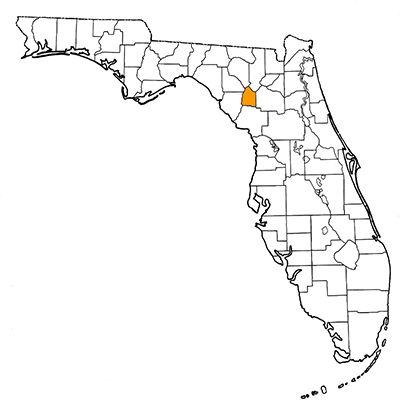
Overall Geographic Range
Floridatragulus dolichanthereus is only known from Thomas Farm, Gilchrist County, Florida (Patton, 1969; Honey et al., 1998).
Florida Fossil Occurrences
Florida fossil sites with Floridatragulus dolichanthereus:
- Gilchrist County—Thomas Farm
Discussion
The holotype skull of Floridatragulus dolichanthereus (Figure 2A) was collected at Thomas Farm by field crews of Harvard University’s Museum of Comparative Zoology in the late 1930s. Initially, the genus and species were placed in the exinct family Hypertragulidae, which is where the genus name comes from (Florida + tragulid). Hypertragulids are primitive, small-bodied members of the ruminant group of artiodactyls, which includes deer, sheep, and bison.
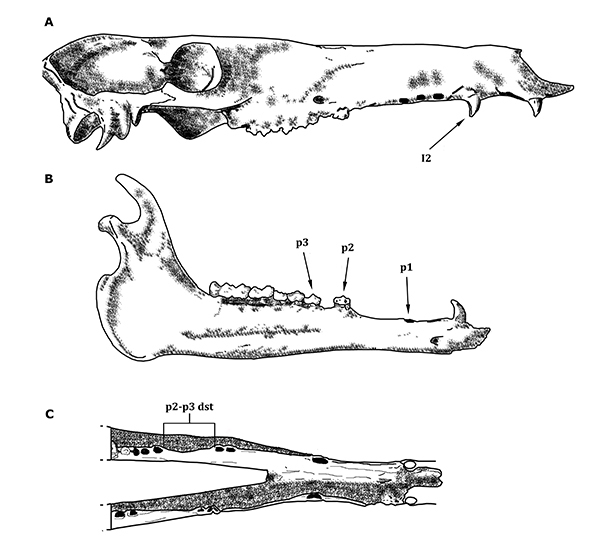
There are three relatively large-sized, brachyodont artiodactyls found at Thomas Farm: Floridatragulus dolichanthereus, Nothokemas floridanus, and Prosynthetoceras texanus. It is important to note that they collectively represent only a small percentage (< 8%) of the relative abundance of mammals at this locality; the faunal assemblage is dominated by three-toed horses (Hulbert, 1984; Pratt, 1990). Even though the record for ungulates in Thomas Farm is remarkably diverse and one of the best well known early Miocene fossil localities in southeastern U.S., F. dolichanthereus is still extremely rare, with less than a 100 known specimens.
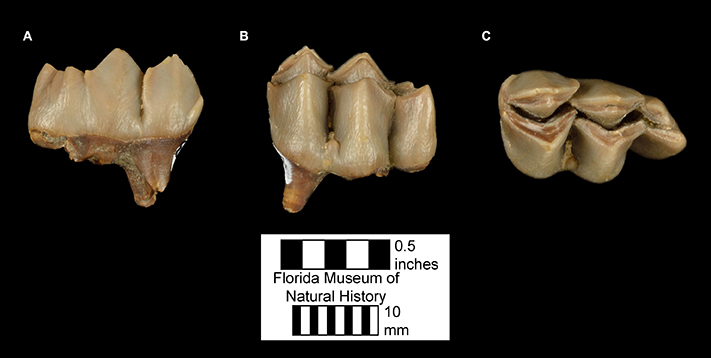
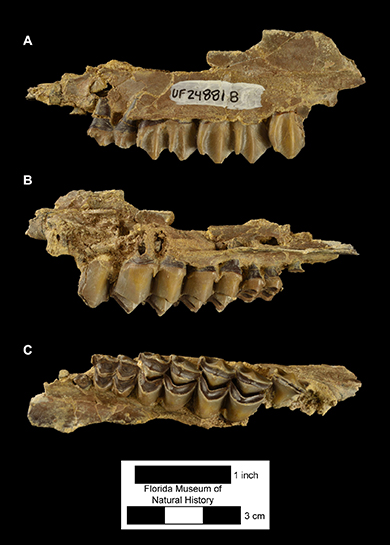
The genus Floridatragulus is characterized by having a brachyodont dentition (Figs. 2-4), a very long mandibular symphysis, a distinctive diastema between the second and third lower premolars (p2 and p3, respectively; Fig. 2C), and a “double enamel loop” on the lower third molar (m3: Figure 3; White, 1940; Honey et al., 1998). Because of the particular combination of characters present in the holotype of F. dolichanthereus, especially the open orbit and the anterior diastemata, members of this genus have been classified in several different families (Prothero, 1996; Honey et al., 1998). After continued collection efforts at Thomas Farm in 1940-1941, White described a second new “hypertragulid”, which he called Hypermekops olseni (White, 1942). He proposed that Floridatragulus was a possible ancestor of Hypermekops, while recognizing that more complete material would be necessary to support his idea. After additional field work was done during the winter of 1946, White described a second species of Floridatragulus, F. barbouri, which was based on a partial lower dentition. The new taxon was diagnosed by having slightly smaller lower molars and a shorter p2-p3 diastema than F. dolichanthereus (White, 1947).
Two decades later, Maglio (1966) recognized that specimens from Thomas Farm that White (1940, 1942, 1947) had named or referred to Hypermekops olseni, Floridatragulus dolichanther-eus, Floridatragulus barbouri, and Syndyoceras australis all represented just a single species. As the oldest available species name, F. dolichanthereus, is the proper name for these fossils. Maglio (1966) also demonstrated using characters of the mandible that it belonged to the family Camelidae, but within a new subfamily, Floridatragulinae (Maglio, 1966). The subfamily Floridatragulinae represents an extinct lineage of tropical to subtropical camelids. They are distantly related to the currently living members of the subfamily Camelinae, which is composed of the tribes Camelini and Lamini (Prothero, 1996; Honey et al., 1998). Floridatragulus dolichanthereus is the only floridatraguline camel currently known from Thomas Farm. Three other species are placed in the genus Floridatragulus: F. hesperus, F. texanus, and F. nanus. They are known from early to middle Miocene faunas in Texas and Nebraska (Patton, 1969; Honey et al., 1998).
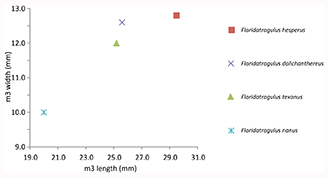
Floridatragulus dolichanthereus differs from the middle Miocene F. texanus by having larger premolars and a distinctive talonid on the m3 (Patton, 1969). F. dolichanthereus differs from F. hesperus in being smaller (~12%), and having distinctive morphology on the lower m3 (Patton, 1969). F. dolichanthereus differs from F. nanus by its larger size (Figure 5).
To date, the subfamily Floridatragulinae includes two genera: Aguascalientia and Floridatragulus. Phylogenetic analyses have also placed Poebrotherium franki from the Chadronian of Texas with these two genera (Honey et al., 1998), which means Poebrotherium franki needs a new genus name to reflect this relationship with the other two genera. The genus Aguascalientia is from the Arikareean and Hemingfordian of Central America (Rincon et al., 2012). This genus is known from several species: A. wilsoni, A. panamaensis, A. minuta, and a partial dentition referred to as Aguascalientia sp. Aguascalientia wilsoni is from the Hemingfordian Zoyotal Fauna from Mexico; Aguascalientia panamaensis and A. minuta are from the late Arikareean of Panama; and the partial dentition is from the middle Arikareean Castolon Fauna from Texas. A detailed study of better-preserved fossils of Aguascalientia from the Panama Canal suggests a tropical origin for Floridatragulinae; they likely descended from an unnamed small camelid from the early Arikareean Buda Local Fauna (Frailey, 1979; Rincon et al., 2012).
Sources
- Original Author(s): Aldo F. Rincon
- Original Completion Date: October 5, 2012
- Editor(s) Name(s): Natali Valdes, Richard Hulbert Jr.
- Last Updated On: June 23, 2021
This material is based upon work supported by the National Science Foundation under Grant Number CSBR 1203222, Jonathan Bloch, Principal Investigator. Any opinions, findings, and conclusions or recommendations expressed in this material are those of the author(s) and do not necessarily reflect the views of the National Science Foundation.
Copyright © Florida Museum of Natural History, University of Florida